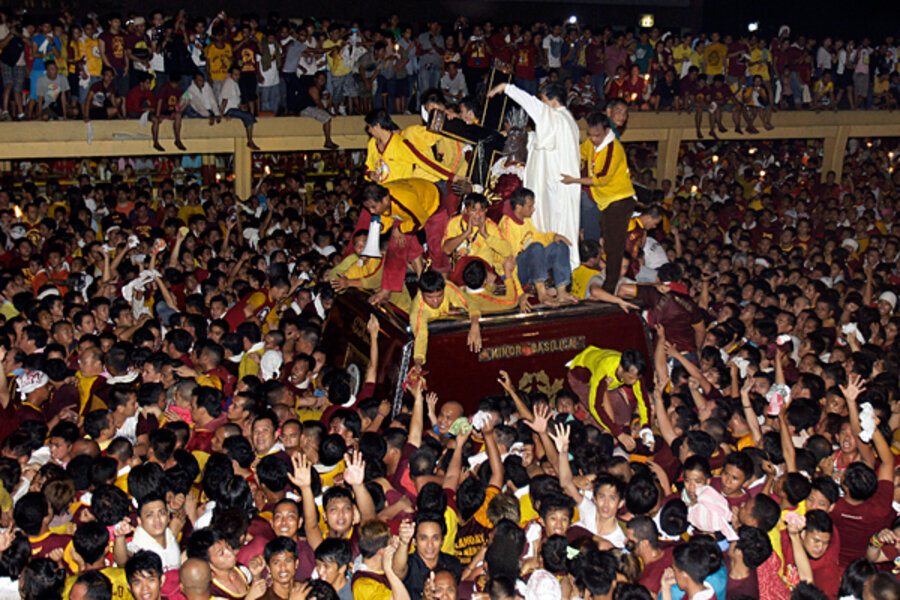Millions of barefoot Filipino Catholics defy terror warning
Loading...
| Manila, Philippines
Millions of Roman Catholic devotees paraded with a statue of Christ through the Philippine capital under a massive police cordon Monday after the president warned that terrorists might target the raucous annual procession.
The government did not have specific intelligence on a terrorist plot. Still, about 15,000 policemen, backed by hundreds of army troops, secured the three-mile (five-kilometer) procession route for the charred wooden Black Nazarene statue from seaside Rizal Park to a popular church in Manila's congested Quiapo district.
Air force helicopters stood by and cellphone service was blocked in procession areas to prevent its use to trigger bombs. Despite the president's warning, huge crowds of devotees wearing maroon shirts surged near the statue, believed to have healing powers.
"It's a choice between faith and fear," said Rodolfo Uy, whose 12-year-old son pushed him on a wheelchair to see the Black Nazarene. "I got nervous last night when I heard the news but my devotion was stronger."
Mr. Uy said he prayed for metal braces so he could walk and work again for his children.
President Benigno Aquino III announced in a hastily called news conference Sunday that several terrorists had been reported in the capital with plans to disrupt the procession, but that the threat was not high enough to cancel the procession and that police would work to keep it safe.
Defense Secretary Voltaire Gazmin said the threat, involving possible bombings by two groups of Muslim militants from the country's volatile south, prompted police to raid several suspected terrorist hideouts in the Manila area, but without any results.
Gazmin defended President Aquino's decision to announce the threat on the eve of the procession despite the absence of a specific threat, saying it underscored the president's concern for public safety and racheted up massive security preparations.
Aquino's warning sparked one of the most elaborate security deployments for an event in the capital in recent years, but Gazmin dismissed criticisms of a security overkill.
"It's OK if it can be described as overreacting," Mr. Gazmin said. "But at least we won't be sorry."
The event got under way with a morning Mass by Manila Archbishop Luis Antonio Tagle at Rizal Park attended by about 3 million mostly barefoot devotees. The crowd was expected to swell to 9 million later in the day, police said.
After the Mass, where prayers were offered for victims of recent deadly floods, organizers brought the life-size Black Nazarene statue down from a stage to a carriage for a procession expected to last well into the night.
Dozens were hurt when a crowd surged forward to try to touch, kiss and dab their towels on the statue, toppling iron railings and pinning other devotees. The Red Cross said it treated more than 250 people with bruises and other minor injuries throughout the day, including some from the morning melee.
The carriage's wheels later broke, slowing the procession. Authorities said the parade might be cut short as it dragged on into the night.
In addition to hundreds of army troops, the military said it deployed 19 teams of explosive experts, 33 units with bomb-sniffing dogs, crowd-control squads and ambulances. It put a 500-member rapid reaction force and three helicopters on standby.
There were suspicions that attackers might come from two radical Muslim groups, including the Al Qaeda-linked Abu Sayyaf, which is on a US list of terrorist organizations for deadly bombings, kidnappings, and beheadings.
The wooden statue of Christ, crowned with thorns and bearing a cross, is believed to have been brought from Mexico to Manila in 1606 by Spanish missionaries. The ship that carried it caught fire, but the charred statue survived and was named the Black Nazarene.
Some believe the statue's survival of fires and earthquakes through the centuries and intense bombings during World War II is a testament to its powers.
The Philippines is Asia's largest predominantly Roman Catholic nation.







